Fighting Jim Crow on the High Seas - Everyone Helping the Strikers
The striking seamen received help from many quarters. Members from many other union joined picket lines, as did the Women’s Shopping League and other disparate organizations. Dorothy Day’s Catholic Worker movement set up a soup kitchen for the strikers. Neighborhood support was widespread.
In stark contrast to the peanut butter sandwiches and hot coffee provided by neighbors and friends and the pacifist Catholic Worker movement, there was also a far darker and more violent kind of involvement.
The strikers themselves were subjected to violent attack both by police and by strong men hired by the ship owners. Contemporary accounts estimate 28 seamen died over the course of the strike.
The strikers and some of their supporters responded with violence. Scabs—strike breakers—risked serious injury at times.
Recounting a serious attack on strike breakers, Joe Stack exclaimed: We were fighting for our very Goddamned lives!
Ladling Soup at Headquarters
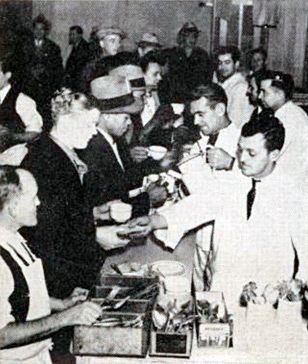 Photograph from Gottlieb, This is the NMU (1956), courtesy of Tamiment Library, New York University.
Photograph from Gottlieb, This is the NMU (1956), courtesy of Tamiment Library, New York University.
Seventeen hundred men were fed daily at the main soup kitchen on 26th St. near strike headquarters, according to Ted Lewis, the Strike Strategy Committee member responsible for feeding strikers during the Fall Strike.
Lewis described how soup kitchen duties were split into six watches, mostly older men, those unable to do picket duty.
He recounted how Brother Abolin, formerly carpenter on the freighter Pennsylvania, built the soup kitchen on a five dollar bill and what we could bum. Brothers Finstead and Sanders were the plumbers (par excellence, late of the President Taft). The Irish stew is delicious—the mainstay of strikers.
Lewis was interviewed for the Dec. 14, 1936 issue of the I.S.U. Pilot.
Black and White Seamen Eat at the Soup Kitchen
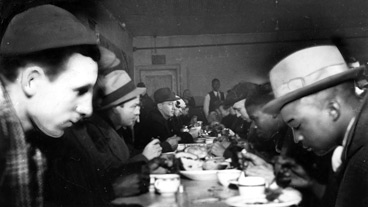 Photograph from Daily Worker/Daily World Photographs Collection, Box 157, folder 22867, courtesy of Tamiment Library, New York University.
Photograph from Daily Worker/Daily World Photographs Collection, Box 157, folder 22867, courtesy of Tamiment Library, New York University.
The article in the I.S.U. Pilot continues: 100 seamen, black and white, were eating while Brother Lewis talked.
Ferdinand Smith
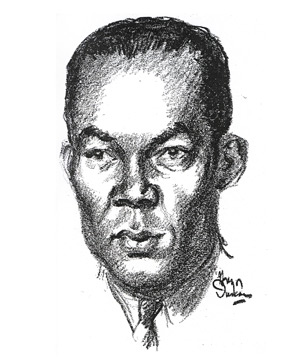 Drawing by Gregor Duncan from Paxton, Two Years (1939), courtesy of Tamiment Library, New York University.
Drawing by Gregor Duncan from Paxton, Two Years (1939), courtesy of Tamiment Library, New York University.
The Dec. 14 article continues: Behind it all stands the tall figure of Brother Ferdinand Smith of the Commissary Department, who works without a let-up night and day to feed the men.
Catholic Worker Soup Kitchen
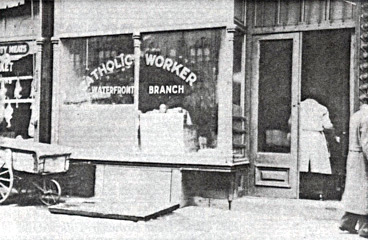 Photo courtesy of Carolyn and Mary Beth Zablotny, Dorothy Day Film Company.
Photo courtesy of Carolyn and Mary Beth Zablotny, Dorothy Day Film Company.
Strike veteran Joe Stack speaking at the 50th anniversary celebration of the Fall Strike at Cooper Union in 1986:
One of the important things was—while I say we didn’t have no support. We had Ryan, we had all the goons, and everything like that. There was only one group that supported us and that was the Catholic Worker—Dorothy Day. And you know when you’re fighting for your life, when you’re fighting for your life, and everyone is against you. And you don’t know what a wonderful inspiration that was to the seamen when they opened up that soup kitchen and seamen could get their peanut butter and jelly sandwich. It may not sound like much, but it was a lot then.
Dorothy Day’s Catholic Worker organization set up a soup kitchen at 10th Avenue & 21st Street to feed hungry striking seamen during the Fall Strike.
Joe Stack:
And you don’t know what a wonderful inspiration that was to the seamen when they opened up that soup kitchen and seamen could get their peanut butter and jelly sandwich. It may not sound like much, but it was a lot then.
Dorothy Day
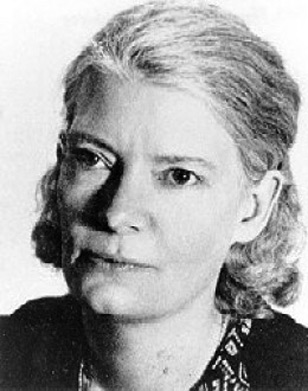 Photograph courtesy of The Catholic Worker.
Photograph courtesy of The Catholic Worker.
Actress Blanche Cholet played Dorothy Day at the 50th anniversary celebration of the Fall Strike, paraphrasing from Day’s January 1937 writings in The Catholic Worker:
At 3 a.m. last Tuesday a New Year’s present was delivered to the Catholic Worker (Waterfront Branch) via the front window. It came in the form of a paving stone. We now have a new window and half of the stone is used to bolster up our stove and the other half is used to keep the bread knife sharp, as we are slicing up 150 long loaves of bread daily. Four large coffee pots are going continuously from 7 a.m. to 9 p.m.
Dorothy Day, co-founder of the Catholic Worker movement, was first approached for help by striking seamen during the Spring Strike. She had just opened up a new “house of hospitality” for homeless New Yorkers—and generously turned it over for the strikers to use. (She and her co-workers doubled up in rooms back at their original site.) Dorothy Day went a step further during the Fall Strike. She opened a soup kitchen at Tenth Avenue, a block from strike headquarters. There she kept thousands of strikers alive, feeding them peanut butter sandwiches and oceans of coffee, completely depleting her own organization’s treasury in the process.
Women’s Shopping League Supports Strikers
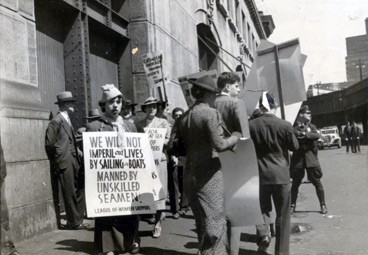 Photograph from Daily Worker/Daily World Photographs Collection, Box 157, folder 22867, courtesy of Tamiment Library, New York University.
Photograph from Daily Worker/Daily World Photographs Collection, Box 157, folder 22867, courtesy of Tamiment Library, New York University.
The range of support offered to the strikers was impressive. To aid striking seamen, Orson Welles and John Houseman staged a midnight benefit performance in Harlem. Will Geer’s Actors Repertory Company did the same at a 48th St. Theatre booked for the evening by “The Emergency Committee for Striking Seamen.” Congressman Vito Marcantonio railed against safety violations aboard ships manned by strikebreakers. The Seamen’s Church Institute donated dormitory-style lodging for strikers. The Seamen’s YMCA at 23rd St., and the “Y” on Jane St., offered free lodging for one night, and reduced the cost of a shower to 2 ½ cents.
Fred (or Frank) Blossom, librarian of the Museum of the American Indian (at its original location on 135th St.) allowed strikers to sleep on cots in the corridors between the collections stacks—for which he was fired.
Organizations like the Women’s Shopping League walked in picket lines in front of passenger terminals—some dressed in fur coats! The picket sign reads: WE WILL NOT IMPERIL OUR LIVES BY SAILING ON BOATS MANNED BY UNSKILLED SEAMEN!
On the East Coast, Violence
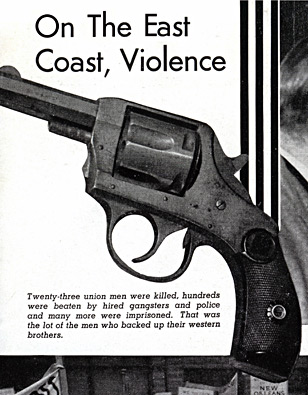 Photograph from Men and Ships (1937), courtesy of Tamiment Library, New York University.
Photograph from Men and Ships (1937), courtesy of Tamiment Library, New York University.
Strike veteran Joe Stack speaking at the 50th anniversary celebration of the Fall Strike at Cooper Union in 1986:
What we used to do with these guys. We’d catch them coming out of a pier, some of them were real naïve. They weren’t what you’d call real profession scabs. A guy would come out with a white coat on. Well shit, you’d knew he was a waiter on a ship. And we’d take the guys we’d say, “Okay, we’re going to take you up to the soup kitchen. The educational committee—we’re going to have a talk with you. So we’d talk with the guy on the way going up. If we found out that he was just an arrogant guy, he didn’t want to be listened to, well before we got him up there we’d dump him on the street. I remember a woman one time we didn’t waste no time with these guys with gentlemen rules and fairness and all this bull shit. We were fighting for our lives. So we’d take maybe five or six guys, dump a fink so you didn’t waste any time. One guy’d give him the boots, the other guy hit him in the head. This and that and knock him down, break his bones if possible, you know.
I remember one time, a woman come along and she’s screaming and hollering, “HEY! Hey! Don’t! Stop hitting that man! What are you doing?”
So this one guy says, “Hey, lady! Don’t pay no mind. This guy’s a scab.”
Like as if it made any difference. But that was our attitude. We didn’t look upon this as—we were fighting for our lives. Queensbury rules and all that didn’t really [matter]. The main theory was if you could break a guy’s leg you could keep him from going on a ship and taking the ship out. Or …if you could get his seamen’s papers. You could take them and tear them up. It would take him a couple of weeks to get a new set of papers. So that would keep him off the ship—anything to constantly harass the shipowners and keep the ships in port.
A terrible toll in lives of strikers was exacted by the Fall Strike. Contemporary journalists claimed several dozen strikers died of beatings from goons, gunshot wounds, or pneumonia (from picketing in the bitter cold). Strikers were not above responding with violence on occasion, as Joe Stack recalls.
A Striker is Shot
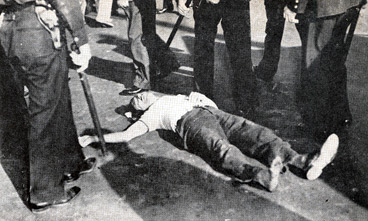 Photograph from Gottlieb, This is the NMU (1956), courtesy of Tamiment Library, New York University.
Photograph from Gottlieb, This is the NMU (1956), courtesy of Tamiment Library, New York University.
Some of the worst violence of the Fall Strike occurred in the port of Houston, Texas. Striker Johnny Kane was shot dead outside the union hall by an I.S.U. official.
Two weeks later, in “the Christmas Eve Massacre,” dozens were arrested and fully 75 sent to the hospital when police burst into seamen’s union halls, clubbing indiscriminately. The violence was allegedly fueled by a case of whiskey donated to the waterfront police by the Lykes Brothers steamship line.
Funeral for a striker who died of pneumonia
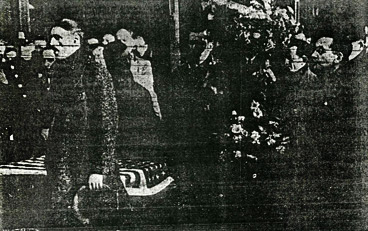 Photograph from the I.S.U. Pilot.
Photograph from the I.S.U. Pilot.
Strike Strategy Committee member Jack Lawrenson, famed among strikers as an orator, eulogized a New York striker, dead of pneumonia.
Other strikers also suffered ill health, as Dorothy Day described in The Catholic Worker in January, 1937:
One fellow I noticed sleeping—his head on the long table in the middle of the room most of the afternoon. Later he came up to get a cup of coffee at the stand by the kitchen door and said he had a chill. I noticed that his eyes were bleary and that he looked feverish, and recommended that he sleep on one of the two beds in the back room where Bill and Joe are sleeping now (their beds are already taken at Mott Street).
One of the seamen recommended eucalyptus oil on sugar and went out to get some, and we dosed him with that, but he continued to lie there, shivering under heavy quilts and coughing rackingly.
I got a thermometer later and took his temperature and it was 103. The only place he had to stay was a 20-cent lodging house in the neighborhood, so thinking a hospital the best place for him, I called a taxi and took him down to St. Vincent’s.








